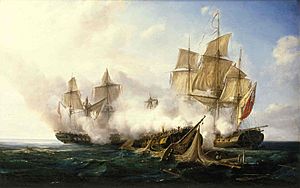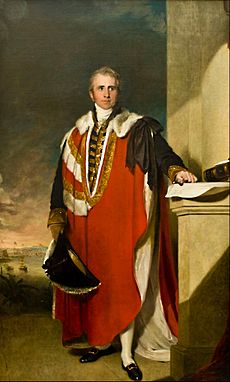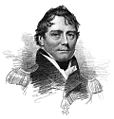Murray Maxwell facts for kids
Quick facts for kids
Sir Murray Maxwell
|
|
|---|---|

Captain Murray Maxwell, 1817
|
|
| Born | 10 September 1775 Wigtownshire, Scotland |
| Died | 26 June 1831 (aged 55) Lincoln's Inn Fields, London, England |
| Allegiance | |
| Service/ |
|
| Years of service | 1790–1831 |
| Rank | Captain |
| Battles/wars | French Revolutionary Wars • Siege of Toulon Napoleonic Wars Action of 4 April 1808 Adriatic campaign • Action of 29 November 1811 |
| Awards | Knight Bachelor Companion of the Order of the Bath |
Captain Sir Murray Maxwell (born September 10, 1775 – died June 26, 1831) was a brave officer in the Royal Navy. He served during the French Revolutionary Wars and the Napoleonic Wars. He was known for his leadership and courage.
Maxwell became famous during the Adriatic campaign of 1807–1814. He destroyed a French convoy of weapons in 1811. Later, he was chosen to escort the British Ambassador to China in 1816. His ship, HMS Alceste, was wrecked, and he and his crew were stranded on an island. They faced pirate attacks but survived thanks to Maxwell's strong leadership. He was rescued and became a hero, earning a knighthood.
Contents
Early Adventures at Sea
Murray Maxwell was born in Scotland in 1775. His father was an officer in the British Army. Many of Murray's brothers also joined the Army or Navy. At 14, in 1790, Murray began his naval career on HMS Juno.
Three years later, the French Revolutionary Wars began. Maxwell was on Juno when it had to make a daring escape from Toulon harbor. French cannons fired heavily at their ship. He later helped invade Corsica and attack Bastia. His bravery impressed his commander, Sir Samuel Hood.
In 1795, Maxwell was captured when his ship, HMS Nemesis, was taken by French forces. He was quickly exchanged and returned to duty. But in 1796, his next ship, HMS Hussar, was wrecked, and he became a prisoner again. After a second exchange, he became a lieutenant in the Navy. In 1798, he married Grace Callander Waugh.
Fighting in the Napoleonic Wars
When the Napoleonic Wars started, Maxwell returned to sea. He commanded a small warship called HMS Cyane. Right away, his ship captured two French transport ships. He also served in the West Indies, fighting French frigates.
In 1803, Maxwell helped capture St Lucia. For this, he became captain of a large warship, HMS Centaur. This was the flagship of his old commander, Sir Samuel Hood. On this ship, Maxwell helped capture French and Dutch colonies like Tobago and Surinam.
His actions at Surinam were highly praised. He led the naval forces in the siege and captured Dutch forts. His quick thinking helped British troops move fast by water. This prevented the Dutch from setting up new defenses. The colony soon surrendered, and the British suffered very few losses.
Battles in the Mediterranean
In 1805, Maxwell took command of the frigate HMS Galatea. He helped protect a convoy of ships from a French attack near Tortola. In 1807, he moved to the Mediterranean Sea on HMS Alceste.
He was part of a group of ships that attacked enemy forts and positions along the Spanish coast. In 1808, he successfully destroyed a Spanish convoy carrying military supplies. For the next two years, Maxwell became very good at raiding French, Italian, and Spanish coasts. He destroyed many small forts and armed ships.
Hero of the Adriatic Campaign
Maxwell's most famous service was during the Adriatic campaign of 1807–1814. His ship, Alceste, was sent to the Adriatic Sea. In May 1810, he led a landing party that stormed and destroyed a coastal fort at Frejus.
In November 1811, Maxwell became the senior officer in the Adriatic. He learned that a convoy of French frigates was trying to sneak past his base. These ships were carrying cannons from Corfu to Trieste. Maxwell quickly led Alceste and two other ships, HMS Active and HMS Unite, to chase them.
On November 29, they caught the French ships near Pelagosa. The French had two large frigates, Pauline and Pomone, and an armed supply ship, Persanne. In the battle that followed, Unite chased and captured the smaller Persanne.
Maxwell on Alceste and Captain James Alexander Gordon on Active fought the two French frigates. It was a fierce battle, and the British had 61 casualties. Gordon himself lost a leg. But Alceste and Active managed to trap Pomone. When another British ship appeared, Pauline fled. Pomone, badly damaged, surrendered.
Maxwell gave most of the credit for the victory to the wounded Gordon. But Maxwell was rewarded in 1812 with command of HMS Daedalus. This was a French frigate captured earlier.
The Loss of HMS Daedalus
Maxwell commanded Daedalus for less than a year. On July 2, 1813, the frigate hit a hidden sandbar off Galle, Ceylon. This caused serious damage to the ship's bottom. Even though they got the ship off the sandbar, it was leaking too badly.
Maxwell had to order his crew to abandon the ship. He was the last person to leave. Soon after he was safely on another ship, Daedalus rolled over and sank. Maxwell returned to Britain for a court martial (a military trial). He was found not guilty for the loss of the ship. He was then given command of Alceste again.
In 1815, he was honored for his naval service. Even though the war against France had ended, he was kept on active duty.
Journey to China and Shipwreck
In 1816, Maxwell was ordered to escort Lord Amherst on a special trip to China. Alceste was joined by a smaller ship, HMS Lyra, and a merchant ship carrying gifts for the Chinese Emperor. The ships sailed for nearly six months, visiting many places.
Lord Amherst went ashore in China for his diplomatic mission. Maxwell and Captain Hall of Lyra decided to explore the Yellow Sea. They became the first British sailors to visit parts of the Gulf of Pecheli and the west coast of Korea. They even saw the Great Wall of China! They also found that Western Korea was charted in the wrong place on maps.
When Maxwell arrived at the Pearl River in China, he was refused entry. A Chinese official threatened to sink his ship if he tried to pass. Maxwell was angry. He said he would pass with or without permission. He then attacked the Chinese defenses, breaking through a blockade of Chinese ships. He fired on the forts guarding the river mouth, scattering their defenders.
He sailed on without any of his crew being hurt. Chinese losses were much higher. Maxwell himself fired the first cannonball. It was reportedly marked "Tribute from the King of England to the Chinese." After picking up Lord Amherst, Maxwell began the journey back to Britain in January 1817.
Stranded and Attacked by Pirates
On February 18, 1817, Alceste entered the Gaspar Strait, a largely uncharted area. The frigate hit a hidden reef and was badly damaged. Maxwell tried his best to free the ship, but it was taking on too much water. He ordered everyone to abandon ship.
Maxwell made sure the ambassador and crew got to a nearby island safely. He was the last to leave the sinking Alceste. On the island, they had very little food and water. Lord Amherst took some boats and 50 men to try and reach Batavia, four days away.
Maxwell organized the remaining 200 survivors. They dug a well for water and salvaged weapons from the wreck. They also built a protective fence on a hill. The next morning, they saw that the wreck of Alceste was surrounded by Dayak (or Malay) pirate boats.
The pirates began looting the wreck. Several pirate boats approached the island. Maxwell quickly set up defenses. The pirates tried to attack several times, but the British were ready. Eventually, Maxwell drove the pirates away from some rocks, hoping to recapture the wreck. But the pirates set Alceste on fire, burning it to the waterline.
On February 26, two pirate boats tried to land where the British boats were anchored. British sailors intercepted them, capturing one boat. Four pirates were killed, and others drowned themselves. Later, 14 more pirate boats appeared, led by a chief. They tried to negotiate, but communication was difficult.
The pirates continued to salvage from the wreck. By March 2, there were nearly 30 pirate boats off the island. They fired at the British positions, but it was ineffective. The British were running low on supplies and expected a big attack. Maxwell prepared a desperate plan to capture pirate boats to escape.
Just then, a British merchant ship, Ternate, appeared on the horizon! Maxwell ordered his marines to wade towards the pirates and fire. This made the pirates move further away. When they saw the Ternate, they left completely.
The next day, all the survivors boarded Ternate. Maxwell had not lost a single man during the shipwreck or the pirate attacks. In Batavia, they reunited with Lord Amherst.
Meeting Napoleon
The journey back to Europe was still full of events. In the Indian Ocean, their ship, Caesar, almost caught fire. They stopped at St Helena, where Maxwell and the other officers met the famous former French emperor, Napoleon Bonaparte.
Napoleon remembered Maxwell's bravery in the battle of November 1811. He praised Maxwell for his victory, saying, "You are very naughty! Well! Your government must not blame you for the loss of the Alceste, for you have taken one of my frigates."
Later Life and Legacy
Maxwell returned to Britain in August 1817. The story of his shipwreck and survival was big news. He was widely praised for his leadership. A military court cleared him of all blame for the loss of his ship. Lord Amherst himself spoke on Maxwell's behalf.
The court said Maxwell's "coolness, self-collectedness and exertions were highly conspicuous." In 1818, he was knighted. The East India Company gave him money to make up for his losses in the wreck. A book about the voyage to China was published, dedicated to Sir Murray Maxwell.
Maxwell tried to enter politics in 1818 but lost the election. He was even injured by a stone thrown by a mob. This left him with a dislike for politics and a chest injury that never fully healed. He returned to the Navy in 1821. An Arctic explorer named Murray Maxwell Bay after him.
In 1823, Maxwell commanded HMS Gloucester, fighting smugglers. Later, he went to South America on HMS Briton. He observed the Peruvian War of Independence and became friends with a defeated general. This trip was difficult for him; he broke his kneecap and didn't make much money.
Maxwell returned to Britain in 1826 and retired. In 1830, King William IV, who was a former naval officer, recalled Maxwell to serve as one of his special aides. Maxwell was then appointed to be the governor of Prince Edward Island in Canada.
However, as Maxwell traveled to London to prepare for his new role, he became very ill. He died shortly after arriving in London in 1831. He was buried in London and was survived by his wife and son. His son, John Balfour Maxwell, also became an admiral in the Royal Navy.
Images for kids






